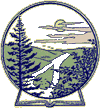by Teri Franzen
Autumn brings with it crisp, cool air, chilly nights and foggy mornings. Multi-colored leaves paint the forest, transforming its uniform green to a vibrant mix of colors. This week's blog features more than just images contributed by our photographers. Each of this week's featured photos is accompanied partially or entirely by the words of our contributors.
1. Japanese Maple
Cheryl Utter photographed this Japanese Maple in the parking lot at Waterman's interpretive center. "Have you ever wondered what makes leaves change color? It's the chlorophyll breaking down. As the days get shorter it affects the amount of sun the leaves are exposed to, causing plants go into a resting state. As the bright green fades away, we begin to see yellow and orange colors emerge, giving leaves a beautiful, fall splendor. Additional chemical changes may occur, which form some of the purples through the development of anthocyanin pigments. Small amounts of these colors have actually been in the leaves all along." - Cheryl Utter
2. Frost
"If you get up early enough in the fall, you can get out and see the beautiful frost that forms over night." Kelly Frederick Sweet. In the image below, Kelly has photographed an extreme closeup of hoarfrost crystals.
Personified by a boy named Jack, frost is not actually delivered by a mischievous adolescent who will nip your nose and bring you chills. Frost forms when a surface becomes cooler than the dewpoint, that is the temperature at which water vapor in the air becomes liquid. Because temperatures are moderated by cloud cover and wind, frost is most likely to form after clear to partly cloudy nights with low winds, typically at temperatures below 40 degrees.
Hoarfrost occurs when the heat of an object radiates into the moist air faster than it can be replaced. This form of frost coats surfaces with a beautiful layer of ice crystals, often feathery in appearance.
3. Oxbow Bend
William Thomas photographed these two images at OxBow Bend in Grand Teton National Park. The first image is the classic, stunning view of Mount Moran during autumn. The second image "...was what I saw after I got into my truck to leave. Noticing the great morning light I quickly got out to capture the tranquil beauty. It was a slight variation on a suggestion from another photographer when I was first learning landscape shooting. He told me to shoot my intended subject, then turn slowly 90° to your left and somewhere in that 90° there was another shot. Repeat the process throughout a 360° circle. This particular shot was not exactly directly behind me but was because I had noticed a nice light when I had practiced that routine earlier. Over the years it has served me well, expanding beyond my tunnel vision with a landscape scene. Keeping your eyes open will allow you to see things that others overlook." - William Thomas


4. Owego Confluence
Gina Vaughan photographed this next image at the Owego Confluence. "I had been hanging around for a while just taking photos of the colors when this beautiful Bald Eagle came flying through. Those are moments I cherish and live for. Nature being the beauty and elegance that it is."
The Owego Confluence is the point of land where Owego Creek flows into the Susquehanna River. Stocked heavily with brown trout, anglers are not the only fishers that benefit from this beautiful resource. Bald Eagles as well can often be found soaring overhead in search of a meal. With fish a primary source of their diet, eagles build their nests high up in trees near the edge of large bodies of water. So next time you head out to fish in Owego Creek, be sure to bring your camera as well. You never know who might be fishing alongside you.

5. Resource Links
6. About the Author
An active member of the Waterman Center board of directors, Teri Franzen is a professional wildlife photographer, videographer, naturalist and conservationist working to promote natural history awareness through photography education. With a strong emphasis on ethics, Teri is passionate about observing and photographing wildlife on its terms, wild, unaltered and undisturbed.


